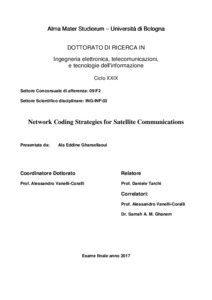Documenti full-text disponibili:
![[img]](http://amsdottorato.unibo.it/8119/1.hassmallThumbnailVersion/thesis.pdf)  Anteprima |
|
Documento PDF (English)
- Richiede un lettore di PDF come Xpdf o Adobe Acrobat Reader
Disponibile con Licenza: Salvo eventuali più ampie autorizzazioni dell'autore, la tesi può essere liberamente consultata e può essere effettuato il salvataggio e la stampa di una copia per fini strettamente personali di studio, di ricerca e di insegnamento, con espresso divieto di qualunque utilizzo direttamente o indirettamente commerciale. Ogni altro diritto sul materiale è riservato.
Download (855kB)
| Anteprima
|
Abstract
Network coding (NC) is an important technology that allows the network services to be optimal. The main advantage of NC is to reduce the necessity for re-transmissions of packets. Satellite Communications (SatComs) are one of the potential applications that can leverage on the benefits of NC due to their challenging fading environments and high round trip times.
The motivation is to take the physical layer-awareness into consideration for adapting and hence extend the NC gains. Different rate and energy efficient adaptive NC schemes for time variant channels are proposed.
We compare our proposed physical layer adaptive schemes to physical layer non-adaptive NC schemes for time variant channels.
The adaptation of packet transmissions is on the basis of the corresponding time-dependent erasures, and allows proposed schemes to achieve significant gains in terms of throughput, delay and energy efficiency.
The proposed schemes are robust for large and small size of packets. Although, the energy per bit is affected, a similar rate and energy gains can be arise. However, the performance gains are not motivated by the packet size, but through duty cycle silence of transfer packets.
In this thesis, virtual schemes are also proposed to solve an open literature problem in the NC. The objective is to find a quasi-optimal number of coded packets to multicast to a group of independent wireless receivers suffer from a different channel conditions.
In particular, we propose two virtual network that allows for the representation of a group of receivers as a multicast group to be visible as one receiver and single channel.
Most of the schemes are applied to LEO/MEO/GEO satellite scenarios. They demonstrate remarkable gains compared to that strategy in which the adaptation depends only on one receiver point-to-point.
Abstract
Network coding (NC) is an important technology that allows the network services to be optimal. The main advantage of NC is to reduce the necessity for re-transmissions of packets. Satellite Communications (SatComs) are one of the potential applications that can leverage on the benefits of NC due to their challenging fading environments and high round trip times.
The motivation is to take the physical layer-awareness into consideration for adapting and hence extend the NC gains. Different rate and energy efficient adaptive NC schemes for time variant channels are proposed.
We compare our proposed physical layer adaptive schemes to physical layer non-adaptive NC schemes for time variant channels.
The adaptation of packet transmissions is on the basis of the corresponding time-dependent erasures, and allows proposed schemes to achieve significant gains in terms of throughput, delay and energy efficiency.
The proposed schemes are robust for large and small size of packets. Although, the energy per bit is affected, a similar rate and energy gains can be arise. However, the performance gains are not motivated by the packet size, but through duty cycle silence of transfer packets.
In this thesis, virtual schemes are also proposed to solve an open literature problem in the NC. The objective is to find a quasi-optimal number of coded packets to multicast to a group of independent wireless receivers suffer from a different channel conditions.
In particular, we propose two virtual network that allows for the representation of a group of receivers as a multicast group to be visible as one receiver and single channel.
Most of the schemes are applied to LEO/MEO/GEO satellite scenarios. They demonstrate remarkable gains compared to that strategy in which the adaptation depends only on one receiver point-to-point.
Tipologia del documento
Tesi di dottorato
Autore
Gharsellaoui, Ala Eddine
Supervisore
Co-supervisore
Dottorato di ricerca
Ciclo
29
Coordinatore
Settore disciplinare
Settore concorsuale
Parole chiave
Adaptive Network Coding; Satellite Communications; Data Rate Efficient; Energy Rate Efficient; Multicast; Virtual Satellite Channel.
URN:NBN
DOI
10.6092/unibo/amsdottorato/8119
Data di discussione
11 Maggio 2017
URI
Altri metadati
Tipologia del documento
Tesi di dottorato
Autore
Gharsellaoui, Ala Eddine
Supervisore
Co-supervisore
Dottorato di ricerca
Ciclo
29
Coordinatore
Settore disciplinare
Settore concorsuale
Parole chiave
Adaptive Network Coding; Satellite Communications; Data Rate Efficient; Energy Rate Efficient; Multicast; Virtual Satellite Channel.
URN:NBN
DOI
10.6092/unibo/amsdottorato/8119
Data di discussione
11 Maggio 2017
URI
Statistica sui download
Gestione del documento:


 Login
Login
